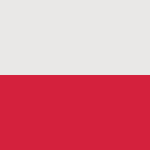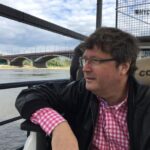Warsaw as the centre of the Polish state
#Warsaw tour guide #Warsaw city guide # guided tour in warsaw #Warszawa tour guide #Warszawa city guide #guided tour in Warszawa
Warsaw Polish capital
When you arrive in Warsaw, you feel, that this is the centre of power. Under communism, Poland was a strictly centralised society and although some decentralisation has taken place, power still emanates from Warsaw. It’s where the specialists are, where the big companies are headquartered and, of course, the capital is the seat of the Polish state administration.
The parliament – Sejm and Senat
Address ul. Wiejska 4/6/8. About one kilometre from Metro Politechnika, a little further from Metro Centrum.
The Polish parliament is divided into a Lower House (Sejm) and an Upper House (Senate).

The Lower House (Sejmen) has been held in a somewhat sombre atmosphere. Note the cross above the door on the left of the picture, which is supposed to remind MPs of Poland’s Christian faith
Originally from 1928, but destroyed and rebuilt after the war
The complex was restored after the war and completed in 1952. These are a series of unpretentious buildings built alongside the parliament hall, which they were able to repair after the destruction of the war. The whole complex is relatively open and inviting, but it can be difficult to get close, as it’s usually fenced off by barriers. Despite the simple modernist form, the materials are of the highest quality, and both the interior and exterior ornamentation refer to the history of power and Poland in their rich detail.

This photo was taken in 2022, when the parliament building was still surrounded by fences and police, making it difficult to get close to the building. This has changed after the election in November 2023, and at some point I’ll make a better picture of the parliament.
Huge halls and reference to antique democratic traditions
The Sejm is shaped like a hemisphere, while the outside of the building is flanked by columns that are meant as a reference to ancient democratic traditions. It is possible to watch the Sejm (lower house) debates from the balcony, which gives you a clear impression of the workplace of the 460 parliamentarians. The hall itself is like a huge amphitheatre and also has clear references to ancient architecture, while the colour scheme can be a bit obscuring. A large cross on the wall reminds legislators of the core Polish values, while a large red and white banner (the colours of the flag) cheers up the gloom.
Ministry of Finance in Warsaw
Address ul. Świętokrzyska 122. A spitball from Metro Nowy Świat Uniwersytet. Read more under “Communism in Warsaw”.
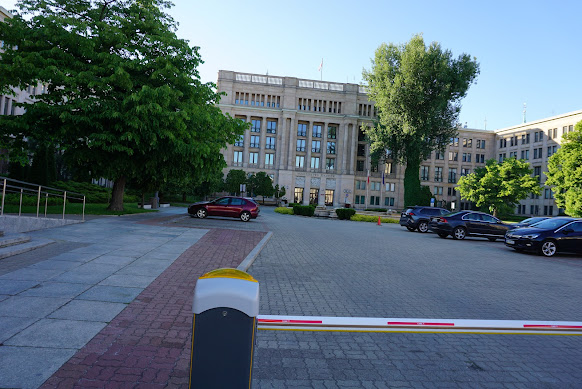
You will find the Ministry of Finance under “Communism in Warsaw”.
Chancellery of the Polish Prime Minister
(Kancelaria Prezesa Rady Ministrów). Address: Aleja Ujazdowskie 1/3.
Here you can observe how there are always one or more cameramen hoping to get comments from important people rushing in and out of the Chancellery.
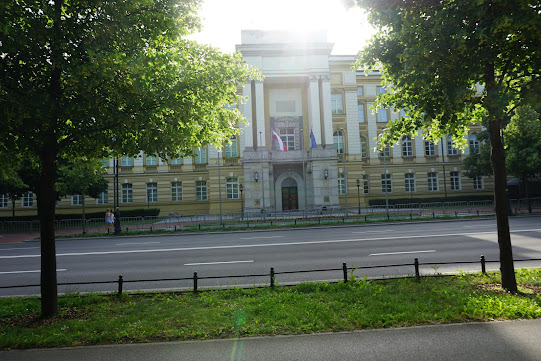
Protesters like to use the the wide pavement in front of the PM’s office
On the opposite side of the street, a wide pavement in front of Łazienki Park is an ideal location for prolonged protests and demonstrations, and when these bother the Prime Minister too much, they have now and then block the terrain and deploy police to prevent the pavement from being used by citizens.

Originally residence for Russian officers before Polish independence
The Chancellery was built under Russian rule in 1903 and was originally intended as a residence for Russian cadets. The building was partially destroyed during the German occupation during WW2. but was rebuilt in 1949.
The building can almost be characterised as Neo-Renaissance, but with solid square columns, and represents a style common in Warsaw.

Warsaw the Capital – 2 hours walking tour with a guide. Price: 350 zloty
Warsaw is the capital of a country of 38 million people and Warsaw has all the central institutions. Please click at the headline to continue.
Belweder – representative building of the head of state
Address: Belwederska 54/56.
Belweder is one of the two mansions of the Polish presidency, and the president can choose to stay here or in the Presidential Palace near the Old Town. The current President Duda has chosen to make his residence the Presidential Palace, but most official visits take place at Belweder.
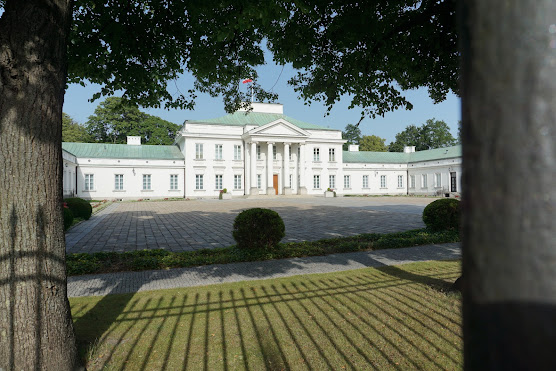
Home to Russian viceroy, German Governor during WWII, Polish freedom hero Piłsudski and president and strike leader Walęsa
It is a neoclassical-style palace from 1822. Since Poland’s restoration as an independent state in 1918, the building has with short brakes been at the disposal of the country’s representative head of state (here I recognise Pilsudski as the unofficial head after 1926), and before that it was periodically the residence of the Russian Tsar’s deputy or viceroy. During World War II, the building was the residence of the German Governor General, Hans Frank.
The building faces the park, is surrounded by a metal fence and in front of the entrance gate you are greeted by a mammoth statue of Polish freedom hero Józef Piłsudski.


The centre of power – Ministry of Defense, Russian embassy, Constitutional court and much more
The centre of power begins about 15 minutes from Metro Politechnika. It has a great location opposite the large royal park, Lazienki Park. The area extends from the Prime Minister’s Office on Aleja Ujazdowskie, which changes it’s name to ulica Belwederska or Belwederska Street immediately after the office. Here you will find the presidential mansion, Belweder. Opposite Belweder is the Ministry of Defence, and immediately after the Ministry of Defence is the Russian Embassy. On the parallel street ulica Szucha are a number of other important institutions: the Ukrainian Embassy, the Constitutional Court, the Ministry of Foreign Affairs and the Ministry of Education.
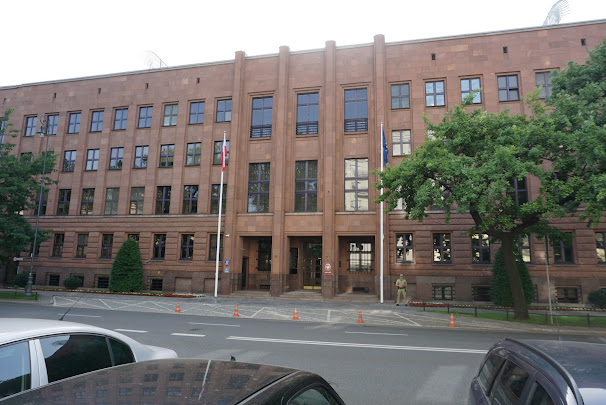

The Russian Embassy
Address: Belwederska 49. A stone’s throw from the Belweder Presidential Residence and the Ministry of Defence. Bus 116 from Castle Square or on weekends from Plac Trzech Krzyży. Read more under “Communism in Warsaw”.

The presidential Palace
(Pałac Prezydencki). Address: ul. Krakowskie Przedmieście 46/ 48. Metro Nowy Świat Uniwersytet.
In 1989, the palace hosted the Round Table, which officially ended the dominance of the Communist Party in Poland
Sometimes also called the Palace of the Deputy (Pałac Namiestnikowski) because the Russian Tsar’s representative in Poland stayed here in certain periods. From 1918-1939 the Prime Minister’s headquarters. During communism, representative premises where the Warsaw Pact was signed in 1955. In 1989, the palace hosted the Round Table, which officially ended the dominance of the Communist Party in Poland. From 1994 at the disposal of the Polish President.
Built in 1643, rebuilt 1856 and not destroyed during WWII
The first version of the palace appeared in 1643, rebuilt in 1856 after a fire. After a number of changes, the palace today appears in neoclassical style. The building was seriously damaged during World War II, where the Germans used it for various purposes. In front of the palace is an equestrian statue made by Thorvaldsen in 1832. The original statue was destroyed during the war, and the current one is a replica based on the original mould, which is placed in Thorvaldsens Museum in Copenhagen. A gift from Denmark to war-torn Poland, the statue depicts General Józef Poniatowski, a nephew of Poland’s last king.

Super luxury hotel Bristol at the right and space for protesters in the front
The palace is flanked by the extravagant Hotel Bristol.
The area in front of the palace is popular for demonstrations, and it’s highly likely that you’ll observe some sort of protest as you walk past.
Plac Piłsudski – the symbols of power
(Piłsudski Square). Behind ul. Krakowskie Przedmieście in a direct line from Hotel Bristol.
Statues, monuments and not longer existing buildings are still present in the collective consciousness
I called the area around Belweder for “The centre of power”; Plac Piłsudski is rather “the symbol of power”. And it’s packed with them, both existing and no longer existing.
The place where all of Warsaw said a final godbye to Polish Pope John Paul II
The square is huge and it was here that the entire population of Warsaw joined together when the Polish Pope John Paul II died in 2005. It’s also where many military parades are held and this is where you are supposed to feel the greatness of Poland.

The square was annexed by the government, when the city of Warsaw refused to place a statue of deceased president Kaczynski at the square
The square belongs to the state, but until 2017 it was administered by the City of Warsaw. However, this arrangement was cancelled after a dispute over the erection of politically charged monuments to the Smolensk air crash in 2010.
Piłsudski is here, so is Kaczyński
At the entrance to the square is a statue of the square’s namesake, freedom hero Józef Piłsudski, who became the leader of Poland after independence in 1918. A larger statue in a more dominant position depicts Lech Kaczyński, who died in the Smolensk plane crash in 2010. Lech Kaczyński is the twin brother of the leader of the opposition PiS party, and the statue’s placement is clearly a political manifestation. Lech is buried in the same crypt as Piłsudski in the old royal castle, Waweł, in Krakow.

Smolensk Monument for the 96 people dead in a plane crash in 2010
Next to the Kaczyński statue is the Smolensk Monument – for the 96 people who died in the Smolensk plane crash in 2010. The aircraft was in dense fog on its way to a memorial service for the murder of Polish prisoners of war during World War II, and the passengers were the very top of Polish society, which was thus exterminated. The plane crash was later used in a political struggle and has helped digging ditches in the relationship between nationalist and Western European-orientated Poles.
The Tomb of the Unknown Soldier and a big cross
In the centre of the square is a huge cross from 2009 in memory of Polish Pope John Paul 2. And finally, the Tomb of the Unknown Soldier stands opposite Piłsudski with an hourly changing of the guard – just to name a few of the square’s most important symbols.
An old Palace of the Saaxon kings may be rebuilt
Even more interesting, however, are the elements that no longer exist: an old palace of the Saxon kings, with whom Poland was in union from 1697 to 1763 and which was destroyed during World War 2. The Tomb of the Unknown Soldier is the last existing remains of this palace, and it has been debated for years as to whether it should be rebuilt – it’s likely to happen soon.
But the old Orthodox church will for sure NOT be rebuilt
Also worth mentioning is the large 70 metre high Orthodox church, the Alexander Nevsky Cathedral, which was completed in 1912. The cathedral was seen as a symbol of Russian rule and was demolished in the 1920s.

The Supreme Court
(Sąd Najwyższy). Address: Plac Krasińskich 2/4/6. Next to the monument to the Warsaw Uprising and the Polish Army Cathedral. Nearest metro station is Ratusz Arsenał.
The Supreme Court is the centre of political disputes about reform of the judiciary
In recent years, Poland has been undergoing a reform process of the court system, with the government seeking to politicise the appointment of judges. The present government is trying to reverse these reforms, but the Supreme Court is marked by these changes, and the square in front of the Supreme Court has been the centre of frequent protests by opponents of this process.
An impressive building from 1996 as a symbol of a new time
The building that houses the Supreme Court was completed in 1996, perhaps symbolically marking the transition from a petty corrupt system to a modern legal system, a new constitution and a new way of thinking. The impressive 76 columns contain legal doctrines in Latin and Polish.

Constitutional Court – it used to defent the Polish constitution
(Trybunał Konstytucyjny). Aleja Szucha 12A. Close to the “Centre of Power” and the Prime Minister’s office.
The Constitutional Court was the first part of the judicial system to undergo reforms after the change of government in 2015. The former PiS government still controls the court, but there will undoubtedly be changes in the coming years.
The building is part of the same complex as the Prime Minister’s Chancery and is characterised by the same solid neo-Renaissance as the Chancery.

The Supreme Administrative Court
(Naczelny Sąd Administracyjny). Address: ul. Gabriela Piotra Boduena 3/5. Metro Centrum or metro Świętokrzyska.

Court of appeal for administrative courts in every province
Like the Constitutional Court, the Administrative Court is an institution that only exists in some countries. Each of Poland’s regions has an Administrative Court, which can point out errors in the handling of cases by public authorities and send cases back for reconsideration. And the Supreme Administrative Court in Warsaw is the court of appeal for these regional courts.
75,000 square metre state-of-the-art building from 2009 which, with its large surfaces and windows, perhaps best can be described as late modernist, and certainly clearly expresses that it is a building that houses power.
The stock exchange
(Giełda Papierów Wartościowych w Warszawie). Address: Książęca 4. Metro Centrum Just behind the White House/National Museum and a side street to Three Crosses Square (Plac Trzech Krzyży).

While you’re there to admire the Square of the Three Crosses, take a few steps down Książęca Street, where you’ll find the stock exchange.
After a 52-year brake, the Stock Exchange reopened in Warsaw in 1991, and since 2000 it has been housed in an award-winning open building in the very centre of the city.
University in Warsaw
The University of Warsaw is in constant competition with the University of Krakow to be the best university in the country. The elite of Polish society emanates from here, and the university leaves its mark on the worldview of the next generation of decision-makers. It’s a huge influence.

The University of Warsaw overtakes Krakow
In one respect, the University of Warsaw overtakes Krakow by several lengths. When commenting on current events, experts are brought in from Warsaw, and it is they who predominantly act as advisors to the central administration. Sure, decentralisation is being attempted, but it’s hard to change the fact that the central administration is located in Warsaw, and this is also where the national TV stations and newspapers are headquartered.

The headquarters of the opposition
Address: Belwederska 84/86
And finally – the headquarters of the main opposition party – PiS (Prawo i Sprawiedliwość/ Law and Justice). They are based in a modest building at Nowogrodzka 84/86, and if you don’t know, it’s hard to figure out that this is where the party leadership controlled MPs, ministers, the president and judges from 2015-2023. The only thing that hinted at the immense power that emanated from here were two police officers who observed me carefully while I photographed.

Opposition headquarters – with a billiard club on the ground floor. It’s hard to imagine that in the years 2015 – 2023 it might have been the most powerful building in Poland. The image may be getting historic and I’ll probably delete it in a year or so. For now, it will remain as a monument to the former government.
Please send an email to m@hardenfelt.pl if you would like an English-speaking tour guide to show you the most important places in Warsaw.
